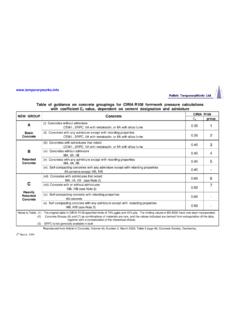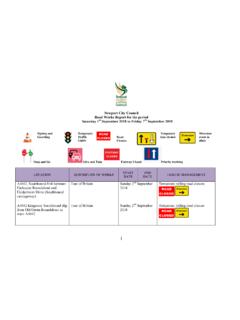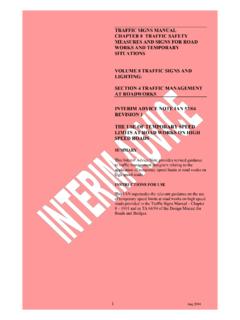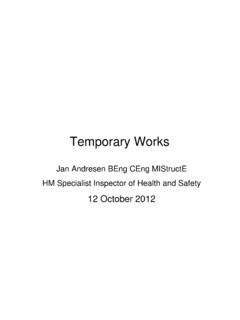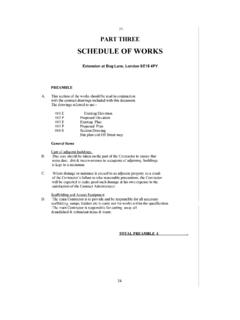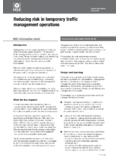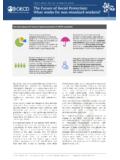Transcription of RR885 - Assessment of current guidance in relation to Safe ...
1 Health and Safety Executive Assessment of current guidance in relation to safe carriageway crossing ( cis53 ) on high speed roads Prepared by the Health and Safety Laboratory for the Health and Safety Executive 2011 RR885 Research Report Health and Safety Executive Assessment of current guidance in relation to safe carriageway crossing ( cis53 ) on high speed roads Deborah Keeley Zoe Chaplin Alison McGillivray Harpur Hill Buxton Derbyshire SK17 9JN This work has assessed the adequacy of current guidance - HSE Construction Information Sheet 53 ( cis53 ) - aimed at clients, designers and workers involved in road works on motorways/ high speed dual carriageways (50mph or greater).
2 The work has comprised of: a literature review; observing workers setting up temporary traffic management; and analysis of traffic flow data. The findings broadly support the present rules set out in cis53 for crossing a carriageway on foot, but have indicated that traffic flows for many motorways make crossing impossible in practice for much of the day. Potentially safe gaps can be assessed by measuring the traffic flow in terms of vehicles per minute. At less than 20 vehicles per minute across all lanes, it is likely that sufficient safe gaps occur so that workers would not have to wait more than 5 minutes to cross.
3 Between 20 and 40 vehicles per minute, it is suggested that site specific Assessment is undertaken to determine if sufficient safe gaps exist. At greater than 40 vehicles per minute it is very unlikely that the carriageway can be crossed safely on foot. These flow rates are intended to be used as a guide and are not to be treated as absolute. This report and the work it describes were funded by the Health and Safety Executive (HSE). Its contents, including any opinions and/or conclusions expressed, are those of the authors alone and do not necessarily reflect HSE policy.
4 HSE Books Crown copyright 2011 First published 2011 You may reuse this information (not including logos) free of charge in any format or medium, under the terms of the Open Government Licence. To view the licence visit , write to the Information Policy Team, The National Archives, Kew, London TW9 4DU, or email Some images and illustrations may not be owned by the Crown so cannot be reproduced without permission of the copyright owner. Enquiries should be sent to ACKNOWLEDGEMENTS The authors would like to thank the Transport Research Laboratory (TRL) for their comments on this report (TRL, 2008).
5 Ii CONTENTS 1 1 1 current guidance .. 1 Structure of Report .. 2 2 LITERATURE REVIEW .. 3 Databases and Search Terms .. 3 4 Discussion .. 6 3 OBSERVATION OF WORKERS crossing THE 7 Analysis of Video Footage .. 7 Discussion .. 8 4 TRAFFIC FLOW DATA .. 9 Selection of Dates and Motorways.
6 9 Analysis Process .. 10 Application of the safe crossing 10 Assumptions .. 11 5 DATA ANALYSIS RESULTS .. 15 safe crossing 15 Time to Wait for a safe Gap .. 16 Mean Flow .. 16 Analysis Results .. 16 Discussion .. 33 6 35 7 APPENDIX A DATA EXTRACTION/ ANALYSIS 37 8 APPENDIX B RELATIONSHIP BETWEEN safe GAPS AND TRAFFIC FLOW 40 M65 2-Lane .. 40 M65 3-Lane .. 44 M55 3-Lane .. 47 M2 3-Lane .. 51 M25 3-Lane .. 54 M6 3-Lane .. 58 M25 4-Lane .. 61 M6 4-Lane .. 65 9 APPENDIX C MISSING DATA.
7 69 10 APPENDIX D FLOW RATE WHEN TIME BETWEEN GAPS IS LESS THAN 5 MINUTES .. 78 iii 11 APPENDIX E MINIMUM HEADWAY .. 87 12 APPENDIX F SENSITIVITY TEST .. 91 13 REFERENCES .. 94 iv EXECUTIVE SUMMARY The Construction Division Technology Unit of the Health and Safety Executive (HSE) commissioned the Risk Science Unit of the Health and Safety Laboratory (HSL) to assess the adequacy of the current guidance in HSE Construction Information Sheet 53 ( cis53 ).
8 cis53 is aimed at clients, designers, contractors and workers involved in roadworks on motorways and high -speed dual carriageways (50mph or greater). Objectives The scope of the project was limited to evaluating the guidance on safe crossing provided in cis53 . The key objectives for this work were: To review existing available research, information and current guidance in relation to crossing the carriageway , especially with respect to the setting up and removal of traffic management equipment; To assess the adequacy of the guidance provided in cis53 in order to identify where the guidance corresponds with current good practice and traffic flow, and areas where the guidance needs strengthening.
9 To make recommendations for revision or strengthening of the guidance to redress deficiencies. One additional aim of the work was to examine whether the current guidance is still applicable for carriageways with four or more lanes. Main Findings The objectives have been met by carrying out a literature review, observing workers setting up temporary traffic management and analysing traffic flow data. The information found in the literature review focussed on keeping crews safe by rejecting crossing the carriageways on foot in favour of other means of setting up temporary traffic management works.
10 No further research on the safe crossing rules was found. However, two reports suggest carrying our night-time road works before midnight in preference to after due to the higher accident rate after midnight. The video footage of workers setting up a temporary traffic management scheme showed that workers generally took 7-8 seconds to cross a 3-lane carriageway . However, they did not appear to wait for safe gaps, as defined by the 3 second per lane rule in cis53 , before crossing . This may be because the traffic flow was relatively high (approximately 32 vehicles per minute) and therefore safe gaps were not appearing with enough regularity.










